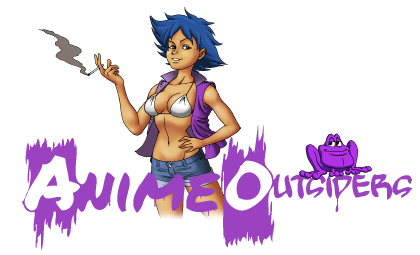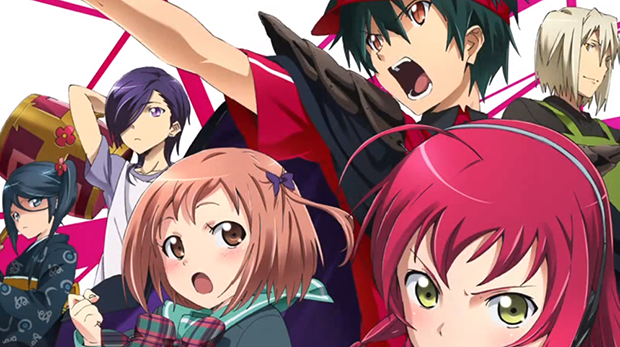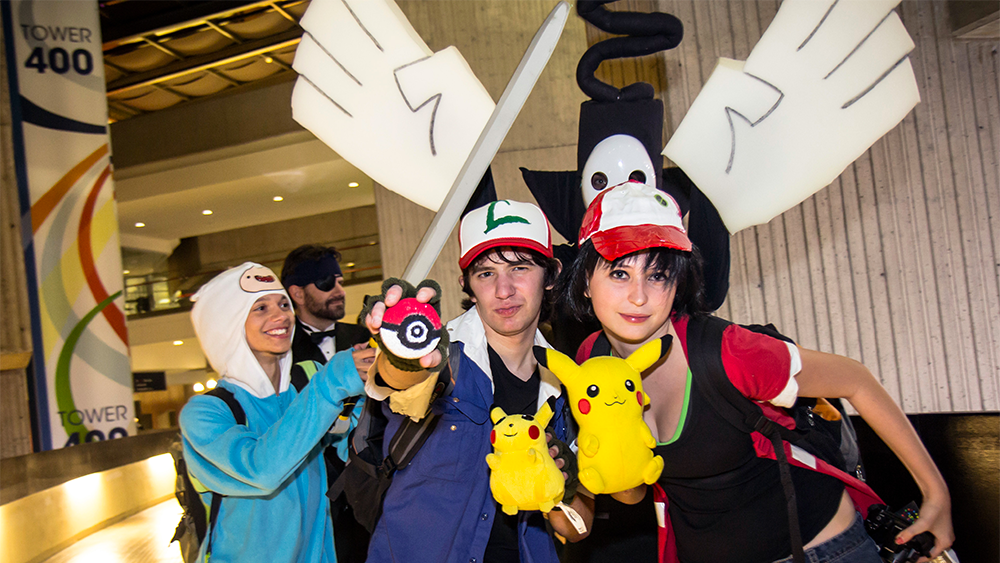Dimension W – Episode 1: Impact

…Or the lack thereof, anyway.
When Dimension W first premiered, I was pretty excited along with everyone else. It looked good; future city, a main character that was well past his teenage years, cyber-punky concept, lots of mature appeal… what wasn’t there to love? Well, one thing actually: the robot girl, who looked like the most stereotypical waifu bait ever conceived. Nevertheless, it wasn’t such deterrence that it prevented me from trying to enjoy the show. Discovering how generic and affect-less it was did, though. And no, it hasn’t gotten any better. Still, it’s hard to pinpoint exactly why Dimension W fails to entice. I’ve seen a lot of bloggers, writers, critics, etc., say the same thing. It’s generic, it’s bland, it’s safe, even the OP having the protagonist dancing along to a song by the same artists who did the Gangsta.opening feels lifeless. Most of them expressed how they couldn’t put their finger on why, and I honestly wasn’t any different. I ended up just chalking it up to being cliché. But thinking about it now, so many good shows start off with clichés. A lot of good shows are cliché in certain ways, in fact.So then, why? Why is a show with so much going for it so goddamn dull? And in the first episode to boot, where hooking an audience is top priority!
Then I re-watched its broadcast dub on Toonami and I started to notice something.

Obviously, the most indispensable things any gripping plot must have are struggle and consequences. The threat of some kind of negative repercussion is what sets most heroes on their journey to endure and overcome trials, thus setting up the story. Now, stories are really made up of smaller stories, if you think about it. That’s why, ideally, every character should have their own arc, and every subplot should eventually be satisfyingly resolved in a way that rounds out the grander tale. Narrowing it down even further, every scene in itself is much like a smaller story in that there should be a definite beginning, middle, and end. With dialogue between characters, there should be a reason why they strike up conversation, an exchange that forwards the plot in some way, and finally a natural conclusion. With fight scenes, we need to know why people are fighting, see the progression of a fight, and observe someone ultimately win. This is common knowledge, I know, and I’m not trying to be patronizing here.

But these are the things I think Dimension W is truly missing, insofar as the first episode is concerned, anyhow. In our very first fight scene, our protagonist, Kyoma, goes up against a mob of thugs in order to retrieve some illegal contraband from them. This only takes place halfway through the running time though. Right when the episode opens, we learn within minutes that he’s not particularly motivated to carry out this job in the first place. Already, the most crucial element of the fight is absent.
To address an even more immediate concern, however, just look at how lame the fight is! “Not everything needs to be flashy Michael Bay nonsense!” I hear people telling their monitors. No, you’re missing the point. Flashiness isn’t the issue I’m getting at. In choosing not to animate the fight scene, Studio 3Hz lets a prime opportunity to give us a glimpse into Kyoma’s character slip through their fingers. Imagine for a moment that the scene had been fleshed out. How would Kyoma react to superior numbers? How would he approach such a seemingly hopeless situation? Head-on, or perhaps more strategically? What is Kyoma’s fighting style? Does he struggle when he has to fend off a dozen goons completely encircling him? In what way? Unfortunately, we don’t bear witness to any of that. Instead, it’s Kyoma simply winning in a sequence of slow-motion images. See, the anime tells us, our main character is a powerhouse that can mop the floor with these punks in mere moments! Fine, but you need to show me that, not tell me.

It’s a bad habit that the anime keeps repeating, too. These so-called coils are devices that can harness inexhaustible energy straight from the depths of a different dimension, they tell us. Illegal coils are therefore very dangerous when fallen into the wrong hands, they tell us. And in order to hang that potential threat over our heads, a demonstration is needed. So the thug boss hooks up an illegal coil to a squirt gun (don’t ask me how) and uses it to disintegrate a water cooler… or so I’m assuming, since the episode cuts away to Mira’s reaction during the actual disintegrating part, thus robbing us of the chance to see what coils are allegedly capable of. It’s so counter intuitive that it’s laughable.
But these scenes thoroughly fall flat on the most basic technical level, as well. When Kyoma uses his signature weapon – oversized sewing needles – for the first time in order to disarm the thug boss, we’re prevented from seeing the blade pierce his wrist. When Kyoma brawls, we’re barred from seeing his fists making bodily contact with his opponents. Can you even call these fights? Again, fights should have a beginning, middle, and end. But Dimension W cuts out the middle entirely. It’s a little like an old army vet regaling his grandchildren with wartime stories by saying, “So there we were, the enemy surrounding us from all sides, when suddenly… we won.”Why, it’s no wonder no one is invested in what’s happening. Where’s the tension in that?
If a fight scene is a story in itself, then the stakes are obvious: pain or death. Every blow, kick, jab, what-have-you should thus be rife with tension. The possibility of a character you like being further injured or dying is suspenseful. The possibility that the same character will triumph over the bad guy you hate is thrilling. That’s why the meeting between a set of knuckles and a jawbone packs so much oomph. It’s a visceral reaction. Seeing the literal physical impact onscreen thus delivers a figurative impact on the audience. Why would you constantly cut away from that? It’s as if Dimension W is pulling its own punches, like it’s afraid to really hit the audience with something substantial. The result is a series of watery, tensionless scenes that leaves you numb.
Even ignoring that, it totally contradicts the show’s own theme. In a future world streamlined to such a high degree, Kyoma stands out like a sore thumb thanks to his hatred of coils. The man doesn’t want unlimited energy. He drives and maintains an obsolete, gas-guzzling race car. They don’t make men like him anymore. So, then, wouldn’t it follow to let us watch how he fights? Highlight the savagery and brutality in Kyoma’s skills as opposed to the ease and detachment with which his counterparts might neutralize foes. Draw a contrast in how Kyoma becomes tired and bloody within minutes while his opponents remain protected and cocksure behind weapons powered by limitless energy. But no, Kyoma’s battles are apparently as flat as his personality. Really, this should have been the perfect chance to world build, but once again Dimension W drops the ball.

Plus, honestly? This is just terrible editing. I’ve never been to film school, but dollars to donuts they’ll tell you that interrupting your own scenes in the middle is an awful way to pace. If one of your main characters is fiercely trying to escape the clutches of the other, for God’s sake, don’t dissolve-wipe into a boring shot of a building! You’re gutting the momentum! You can’t even call this a cliffhanger, because it cuts back to Mira already tied up one scene after. You’ve once more told us what happened without letting us see it for ourselves. Not even Christopher Nolan does that. When he does parallel action, at least it’s because multiple exciting events are happening simultaneously. It’s amazing that I even have to verbalize all this.
In my opinion, this whole sequence should have gone like this. Don’t cut away, actually show Mira becoming ensnared by Kyoma’s wires. Mira is abruptly restrained in midair and comes unceremoniously crashing down onto the concrete, hard, as we hear the earsplitting crunch of her metal body colliding with the unforgiving ground. The impact of her fall makes us wince, despite the fact that she’s a robot. Kyoma looks on apathetically, further illustrating his indifference to modern technology while possibly also acting as a proxy for the rest of the population’s similar disregard for the “suffering” of human simulacra. Mira begins struggling, pleading with Kyoma between dry sobs as she desperately attempts to writhe her way out of her binds and claw her way across the rooftop in order to reach her father halfway across the city. We as the audience realize that, even with all her unnatural strength, Mira is just as helpless and vulnerable as any human being driven into a corner. And at the same time, we empathize with her mad desperation to help her father despite how hopeless the situation is. This starkly contrasts against Kyoma’s unfeeling demeanor and gives the show a chance to capitalize on this clear role reversal between man and machine to have an impact on the viewer. Kyoma watches for a minute as Mira continues to openly despair, and uncertainty finally causes him to momentarily falter. After all, even if you knew the individual in front of you was a machine, wouldn’t you react to some degree if both its appearance and actions resembled a real life person so closely?
Sigh. No, anime, don’t just flash me some sparkly tears.

I mean, yeah,it’s very moe, but who cares? It’s just a gimmicky cliché. Why would her creator even give her the function to produce tears, anyway? See, in utilizing this cliché, Dimension W again misses the point of its own character. Mira resents being called a robot, instead preferring to be seen as a normal girl. Kyoma remarks on the strangeness of a teary-eyed robot, and it probably is within the context of the show, but to us, the audience, it becomes redundant. True, Mira has autonomous ears and a prehensile USB tail, and she certainly has super strength and senses, but all her emotions, actions, mannerisms, overall appearance, etc., are more or less human, even down to the smallest detail, like forming tears! So Dimension W can have Kyoma disparagingly call her a robot as much as he wants, but I simply don’t buy it at the end of the day. To me, she’s a living person. Or about as close as an anime character can be, anyway.Her inner turmoil in wanting to break through that particular glass ceiling, if you will, is therefore lost on me. It has no impact.
What should’ve happened was, while Mira was wrestling to free herself, she then begins to audibly weep without shedding a single tear. The juxtaposition of her physical machine form being unable to express her inner emotions would then be apparent. Y’know, the “I’m sad but I can’t cry” trope.“But isn’t that also a cliché?” some readers are probably asking. Sure, but the problem with Dimension W is that it doesn’t draw a hard enough distinction between Mira’s robotic nature and her humanity. As it is now, Mira acts identical to any young girl you can pick off the street. Biologists, dictionary enthusiasts, and overly pedantic individuals might quibble about defining her strictly as a true blue human, but I don’t think her personhood can justly be called into question. Mira wants to be called a girl? Okay, whatever you say, sweetheart. End of story.

This is really the only impact you’ll be wincing at in this episode. Oh, but it’s just standard anime “comedy” fare…
Anyway, I’ll probably get to the rest of the series once it’s finished airing.



